One intriguing thing during the match was how much Lasker varied his repertory as Black against 1.d4. The 3 games he played with his own Lasker variation in the Queen’s Gambit Declined (1.d4 d5 2.c4 e6 3.Nc3 Nf6 4.Bg5 Be7 5.e3 Ne4) netted him 2.5 points out of 3 games and some pretty good positions so the need to change wasn’t there. However, Lasker also tried the QGD Tarrasch twice, the Dutch once and even a horrific version of a Chigorin.
The QGD Tarrasch games were somewhat fraught, and in the seventh match game, Marshall missed a glorious opportunity to get back into the match after misplaying the huge advantage that he’d built up. We’ll look at this game, as well as the ninth game in which Lasker’s surprise on the fifth move provoked Marshall into a sharp line that only led to liquidation and equality. We’ll also take the opportunity to take a broader look at Marshall’s play in the Tarrasch, both from the White side – using his patented 1.d4 d5 2.c4 e6 3.Nc3 c5 4.cd ed 5.Nf3 Nc6 6.Bg5 variation – and from the Black side from which he championed the interesting sideline (now attributed – perhaps incorrectly – to Keres) 1.d4 d5 2.c4 e6 3.Nc3 c5 4.cd ed 5.Nf3 Nc6 6.g3 Nf6 7.Bg2 cxd4 8.Nxd4 Bc5.
A video of this article is also available at https://youtu.be/8U0x9vDQQ_4 As always, a playable version of this game is available at http://cloudserver.chessbase.com/MTIyMTYx/replay.html
Marshall,Frank James – Lasker,Emanuel [D32]
World-ch07 Lasker-Marshall +8–0=7 USA (5 cities) (7), 16.02.1907
[https://matthewsadler.me.uk]
1.d4 d5 2.c4 e6 3.Nc3 c5 4.cxd5 exd5 5.Nf3 Nc6
[5…Nf6 6.Bg5 Be6 7.e4 shows that the idea of e4 in such positions was well-known to Marshall already! 7…cxd4 8.Bb5+ Nbd7 9.Nxd4 Bb4 10.e5 h6 11.exf6 Bxc3+ 12.bxc3 hxg5 13.Nxe6 fxe6 14.fxg7 Rg8 15.Qh5+ Ke7 16.Qxg5+ Kf7 17.Qh5+ Ke7 18.0–0 Rxg7 19.Rfe1 Nf6 20.Qh3 Qd6 21.Bd3 Rag8 22.g3 Ng4 23.Bf5 Ne5 24.Bxe6 Rf8 25.Qh4+ Rf6 26.Bxd5 Qxd5 27.Qd4 Ke6 28.Rad1 1–0 (28) Marshall,F-Cohn,E Nuremberg 1906;
5…cxd4 A surprising choice from Lasker in the next Black game in the match, presumably played to avoid a repeat of Marshall’s 5…Nc6 6.Bg5 that had caused Lasker such problems (as we shall see!) Marshall calls this move “old-fashioned even for those days” in his annotations to his game against Mieses played 1 year later! (see below). He doesn’t even mention his previous game against Lasker!
6.Nxd4 was Marshall’s sensible and more standard choice in a 1908 game against Mieses, avoiding the immediate conflict that occurs in this game. Compared to the main lines of the Tarrasch, Black has taken very early on d4 which should benefit White through some additional development options. 6…Nc6 Again forestalling Bg5, this time by avoiding committing the knight to f6. 7.Bf4 (7.e4 dxe4 8.Bb5 might also be promising: it looks more disruptive than the same idea in the game after 6.Qxd4.) 7…Bb4 8.e3 (8.Ndb5 d4 9.a3 Ba5 10.b4 is the engine recommendation, already with a clear advantage!) 8…Nge7 9.Rc1 0–0 10.Be2 Bd6 11.Bg3 Nxd4 12.Qxd4 b6 13.Bd3 Bb7 14.Bxd6 Qxd6 15.0–0 Rfc8 16.Nb5 Qd7 17.Rxc8+ Bxc8 18.Rc1 Nc6 19.Qh4 g6 20.Qf6 Nb4 21.Rc7 Qe6 22.Qd8+ Kg7 23.Nd6 Bb7 24.Nxf7 1–0 (24) Marshall,F-Mieses,J Berlin 1908
6.Qxd4 Nf6 7.e4
Marshall tries to exploit Lasker’s unusual move order by forcing means. However, this leads to a simplified position in which Marshall’s advantage is purely symbolic. (7.Bg5 Be7 (7…Nc6 8.Bxf6) 8.e3 Nc6 is a standard IQP position with just the slight drawback for White of an exposed queen on d4. It should still be an edge for White however.) 7…Nc6 8.Bb5 dxe4
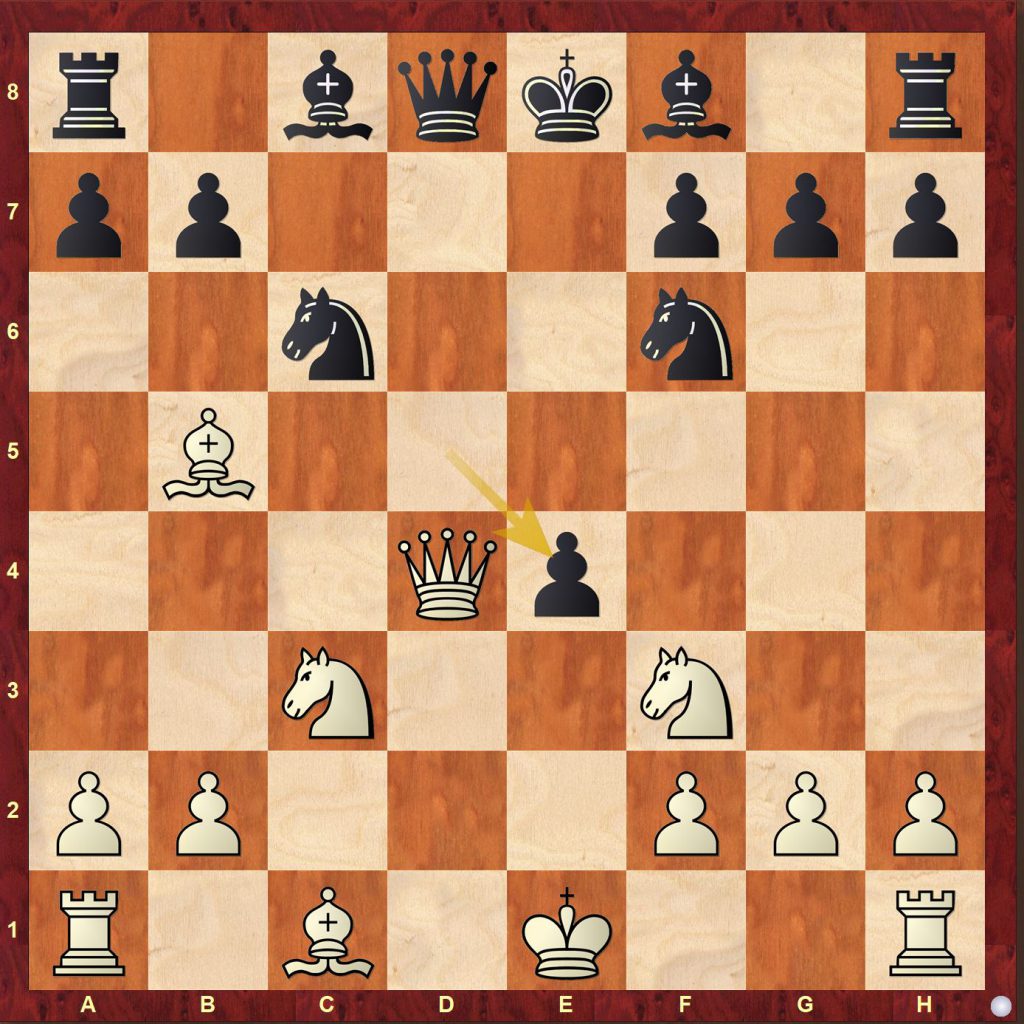
And now there are two possibilities. 9.Bxc6+ as Marshall played, which I felt was a little tame, and 9.Qxd8.
A) 9.Bxc6+ There is always time to capture the knight later, so it is feels worth keeping White’s options open by leaving the bishop on the board for now. 9…bxc6 10.Qxd8+ Kxd8 11.Ng5 Be6 12.0–0 (12.Nxe6+ fxe6 13.Bg5 Bb4 14.0–0–0+ Kc7 15.Bxf6 gxf6 16.Nxe4 followed by bringing the knight to c4 might be a small edge for White, though Black should not have any problems.) 12…Bb4 13.Ncxe4 Nxe4 14.Nxe4 Bd5 and Lasker had no difficulties: in fact he was a little on top for the rest of the game. 15.Bd2 Rb8 16.Rad1 Kc8 17.Nc3 Bc4 18.Rfe1 Rd8 19.Bf4 Rb7 20.Rxd8+ Kxd8 21.Rd1+ Rd7 22.Rxd7+ Kxd7 23.a3 Bd6 24.Be3 a6 25.Bd4 f6 26.Ne4 Bc7 27.f3 Ke6 28.Kf2 Kd5 29.Be3 Be5 30.Nc3+ Ke6 31.Na4 h5 32.b3 Bd5 33.Nc5+ Kf5 34.Nxa6 Bxb3 35.Nc5 Bc4 36.a4 Bxh2 37.g3 h4 38.Bf4 g5 39.Kg2 Bxg3 40.Bxg3 hxg3 41.Kxg3 Ke5 42.a5 f5 43.a6 Bxa6 44.Nxa6 Kd4 45.Nc7 Ke5 46.f4+ ½–½ (46) Marshall,F-Lasker,E USA (5 cities) 1907
B) 9.Qxd8+ Kxd8 10.Ng5 Be6 11.0–0 felt more challenging. 11…Bb4 Continuing as Lasker did in the game. 12.Ncxe4 Nxe4 13.Nxe4 Ke7 14.Be3 Preventing Black’s key defensive idea of …Nd4 and threatening a3, embarrassing the bishop on b4: if it leaves the a3–f8 diagonal, then Black’s king is vulnerable to a check from c5. I was somewhat hopeful of developing an initiative in this way, but was unable to break the following concrete defence… and nor was my engine when I checked my analysis with it. (14.a3 Nd4) 14…Rhd8 Supporting the …Nd4 defence anew. 15.a3 (15.Bxc6 bxc6 16.a3 Ba5 (16…Bd6 17.Nxd6 Kxd6 should also be fine for Black.) 17.Bc5+ Kd7 it looks a little uncomfortable for Black, but there doesn’t seem to be any way for White to extract a lasting advantage.) 15…Nd4 A much-needed resource (15…Bd6 16.Rfd1 Be5 17.Bc5+ Ke8 18.Bd6 is the type of edge that White is aiming for: 18…Bxb2 19.Rab1 is catastrophic for Black.)
a) 16.axb4 Nxb5 17.Bc5+ Ke8 is fine for Black as the knight on b5 covers d6.;
b) 16.Ba4 Ba5 aiming to complete Black’s defensive structure with …Bb6. 17.Nc5 Bb6 (17…b5 18.Nxe6 Kxe6 (18…fxe6 19.Bg5+) 19.Bxd4 (19.Bd1 Rac8) 19…Rxd4 20.Bxb5 Rb8 21.a4 a6 is also fine for Black.) 18.Nxb7 Rdb8 19.Bxd4 Bxd4 20.Bc6 Bxb2 21.Rad1 and now the nice engine move (21.Rab1 Bxa3) 21…Rg8 avoids any discovered attack tricks!;
c) 16.Ba6 bxa6 17.axb4 was a nice idea of mine, but it again doesn’t promise much after 17…Kf8 White has any edge that is going, but this seems a pretty acceptable result with the Black pieces in a World Championship match!)]
6.Bg5 [This idea originated with Marshall in 1905, and he played it regularly until 1910 when he took up Rubinstein’s 6.g3. He scored excellently with 6.Bg5, winning eight, drawing nine and losing just one. I first came across this line in Ray Keene’s excellent “An Opening Repertoire for White” which quoted many of Marshall’s games. It’s an attractive line for White as there are few ways for Black to avoid the basic structure that White is aiming for. By exchanging off the dark-squared bishops, White removes the major source of attacking counterplay for Black, leaving Black with only the disadvantages of the IQP. Black’s position is solid enough, but rather uninspiring to play. Marshall has this to say about 6.Bg5 in his notes to his game against Spielmann: “For some time this was my favourite line of play against the Tarrasch Defence; but later I switched to the more effective Schlechter-Rubinstein move 6.g3 after it had been introduced into master play in 1908.”]
[6.g3 After this move, Marshall frequently played the Black side of a sideline which Alexey Bezgodov in his excellent book on the Tarrasch calls the “Keres variation” but which perhaps could better be ascribed to Marshall! 6…Nf6 7.Bg2 cxd4 8.Nxd4 Bc5
a) 9.Nxc6 bxc6 10.0–0 0–0 11.Bg5 h6 12.Bxf6 Qxf6 13.Nxd5 cxd5 14.Qxd5 Bxf2+ 15.Rxf2 Qxb2 16.Rxf7 Qb6+ 17.Kh1 Be6 18.Rb7 Bxd5 19.Bxd5+ Kh7 20.Rxb6 axb6 21.Be4+ g6 22.Bxa8 Rxa8 23.Kg2 b5 24.Kf3 b4 25.Rb1 Rxa2 26.Rxb4 Ra7 27.e4 Kg7 28.e5 Kf7 29.Ke4 Ra6 30.h4 Ke6 31.g4 Rc6 32.Ra4 Rb6 33.Kd4 Rc6 34.Ra8 Rb6 35.Re8+ Kf7 36.Rc8 Ke6 37.Rc4 Ra6 38.Rb4 Rc6 39.Ra4 Rb6 40.Rc4 Ra6 41.Ke4 Rb6 42.Rd4 Ra6 43.Kf4 Ra1 44.Rd6+ Kf7 45.Rf6+ Kg7 46.Kf3 h5 ½–½ (46) Marshall,F-Duras,O Budapest 1912
b) 9.Nb3 Bb4 10.0–0 Bxc3 11.bxc3 0–0 saw Marshall on the wrong end of a magnificent positional effort from the great Akiba Rubinstein. 12.Bg5 Be6 13.Nc5 Qe7 (13…Rc8 is Bezgodov’s suggested improvement, although his main line still looks pretty pleasant for White: 14.Nxb7 Qe7 15.Rb1 Rc7 16.Qa4 Rxb7 17.Bxf6 gxf6 18.Qxc6 Rc7 when Black regains the pawn on c3, but will be fighting at best for a draw due to his pawn weaknesses.) 14.Nxe6 fxe6 15.c4 dxc4 16.Bxc6 bxc6 17.Qd4 Qd8 18.Bxf6 Rxf6 19.Qxc4 Qd5 20.Rac1 Raf8 21.e4 Qh5 22.f4 Qa5 23.e5 Rh6 24.Rc2 Qb6+ 25.Kg2 Rd8 26.Rff2 Rc8 27.Rfd2 Kh8 28.Rd6 Qb1 29.Rxc6 Rg8 30.Rc8 Qb7+ 31.Kg1 Qb6+ 32.Qc5 Qxc5+ 33.R2xc5 g5 34.Rxg8+ Kxg8 35.fxg5 Rh5 36.h4 h6 37.gxh6 Rxh6 38.Rc8+ Kg7 39.Rc7+ Kg6 40.Rxa7 Kf5 41.Ra5 Rh8 42.Kg2 Rb8 43.Kh3 Rb1 44.Ra3 Rh1+ 45.Kg2 Ra1 46.Rf3+ Kxe5 47.Rf2 Kd4 48.h5 Rc1 49.h6 e5 50.g4 e4 51.h7 Rc8 52.g5 e3 53.g6 exf2 54.g7 Ke3 55.g8Q Ke2 56.Qe6+ 1–0 (56) Rubinstein,A-Marshall,F Breslau 1912]
6…Be7 7.Bxe7 Ngxe7 8.dxc5 [8.e3 Marshall also played this regularly, but had difficulty winning against 8…cxd4 9.Nxd4 0–0 10.Be2 Qb6 11.Nb3 (11.Qd2 was I believe Ray Keene’s recommendation; 11.Qb3 is the engine line with a slight edge for White.) 11…d4 turned out badly for him against Rubinstein in 1907 (the only game he lost in this line). 12.exd4 Rd8 13.d5 Nb4 14.Bf3 Nbxd5 15.Bxd5 Be6 16.0–0 Nxd5 17.Na4 Qb4 18.Qd4 b6 19.h3 Qxd4 20.Nxd4 Bd7 21.Nc3 Nxc3 22.bxc3 0–1 (52) Marshall,F-Rubinstein,A Karlsbad 1907]
8…Qa5 [8…d4 9.Ne4 0–0 was played a few times against Marshall and looks more attractive to me than the main line: at least, White has some specific problems to solve rather than just playing his standard structure.]
9.e3 Qxc5 [9…0–0 10.Bd3 Qxc5 Marshall was very happy about this type of position for White: “Black is on the way to achieving a very fair development, but his position suffers from an ineradicable weakness: the isolated QP. Not only will White be able to exert pressure on this weakness, he will have a strong pressure on the central black squares d4, c5 and e5.” 11.0–0 Be6 12.Rc1 Qb6 led to a game that Marshall considered “one of my best” 13.Na4 Qb4 14.h3 h6 15.a3 Qd6 16.Nc5 Rab8 17.Qe2 Bf5 18.Bxf5 Nxf5 19.Rfd1 Nfe7 20.e4 b6 21.e5 Qd8 22.Ne4 Qc8 23.Nf6+
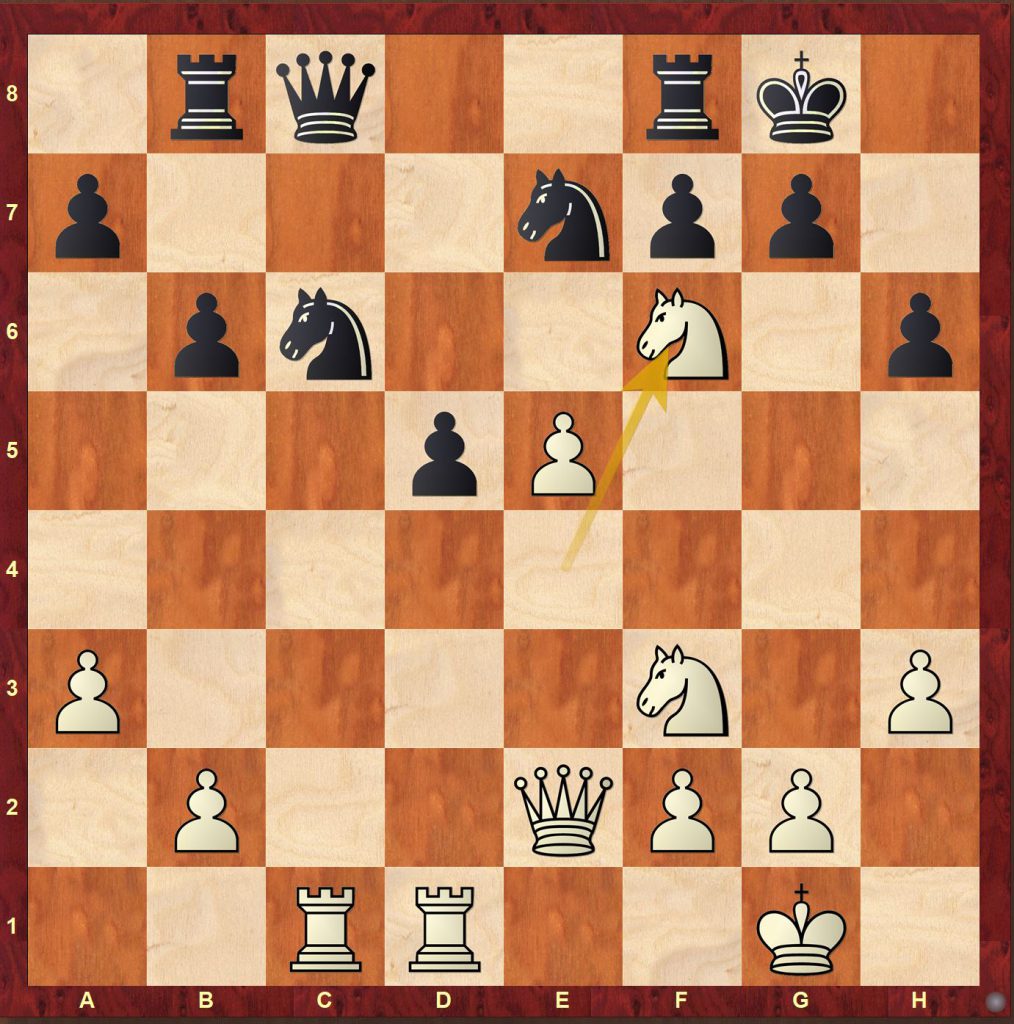
23…gxf6 24.exf6 Ng6 25.Qd2 Qf5 26.Qxh6 Qxf6 27.Rxc6 Qxb2 28.Rd4 Qb1+ 29.Kh2 Qf5 30.Rg4 1–0 (30) Marshall,F-Schlechter,C Ostend 1907]
10.Bd3
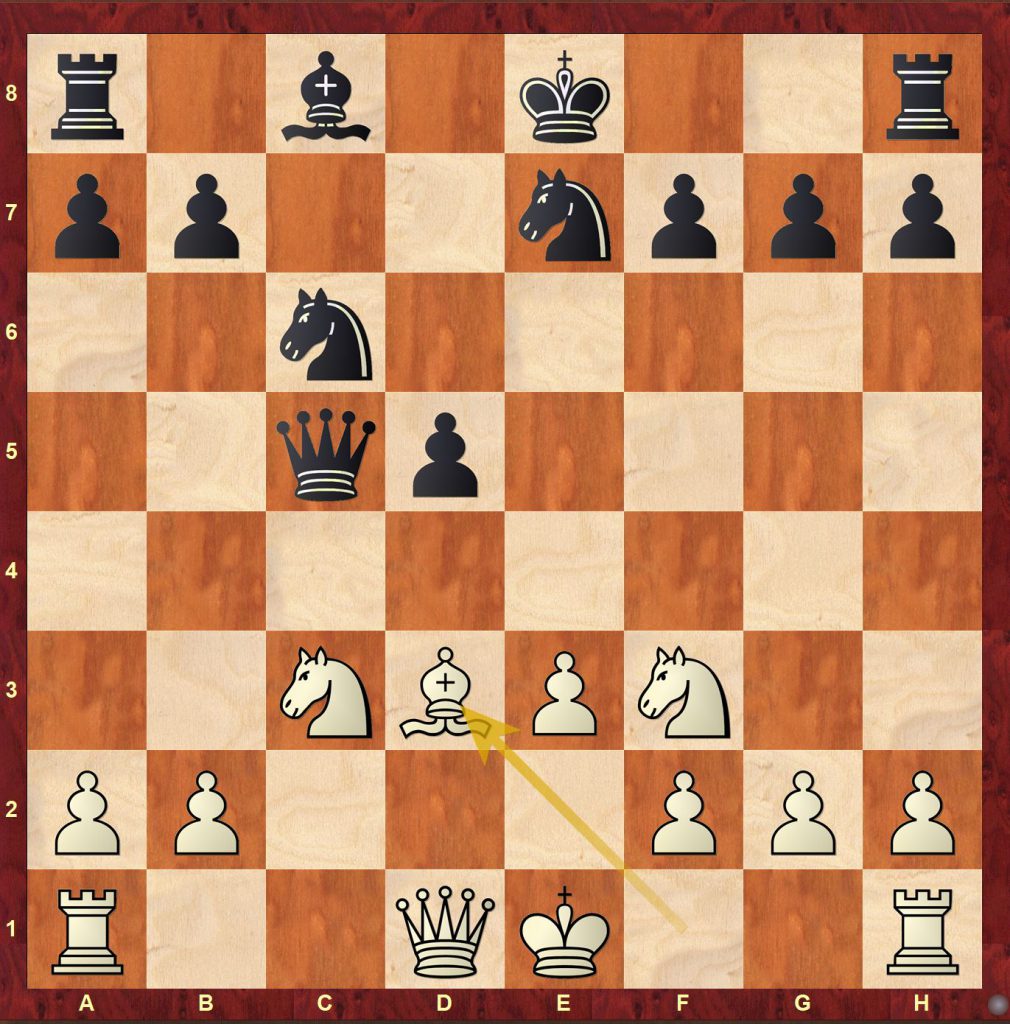
[Marshall’s favourite development of the bishop in this line, rather than the more natural 10.Be2. 10.Be2 anticipates Black’s 10…Bg4, pinning the knight on f3 to the queen, but in a tactical way so does 10.Bd3!]
10…Bg4 11.0–0 Rd8 [11…0–0 12.Bxh7+ is Marshall’s reason for putting the bishop on d3!]
12.Re1 [A clever move, dissuading Black from playing …d5–d4 by placing the rook on the e-file while waiting to see how Black solves the current problem with castling (12…0–0 still allows 13.Bxh7+ Kxh7 14.Ng5+). The prepatory 12…Bh5 seems the best option, followed by 13…0–0 with a decent game for Black. 12.Re1 elicits a very risky reaction from Lasker which Marshall exploits skilfully.]
[12.Rc1 Qb6 13.Na4 Qc7 14.Re1 d4 15.Nc5 b6 16.Nb3 dxe3 17.Rxe3 Qd6 18.h3 Bxf3 19.Qxf3 0–0 20.Qe4 g6 21.Bb5 Rc8 22.Bxc6 Nxc6 23.Rec3 Ne7 24.Rxc8 Nxc8 25.Qb7 Qd8 26.Qc7 Qd5 27.Qb8 Qd8 28.Qf4 a5 29.Nd4 Qd5 30.a3 Nd6 31.Kh2 Rc8 32.Rxc8+ Nxc8 ½–½ (32) Marshall,F-Forgacs,L Hamburg 1910]
12…f5 13.h3 Bh5 14.Be2 0–0 15.Nd4
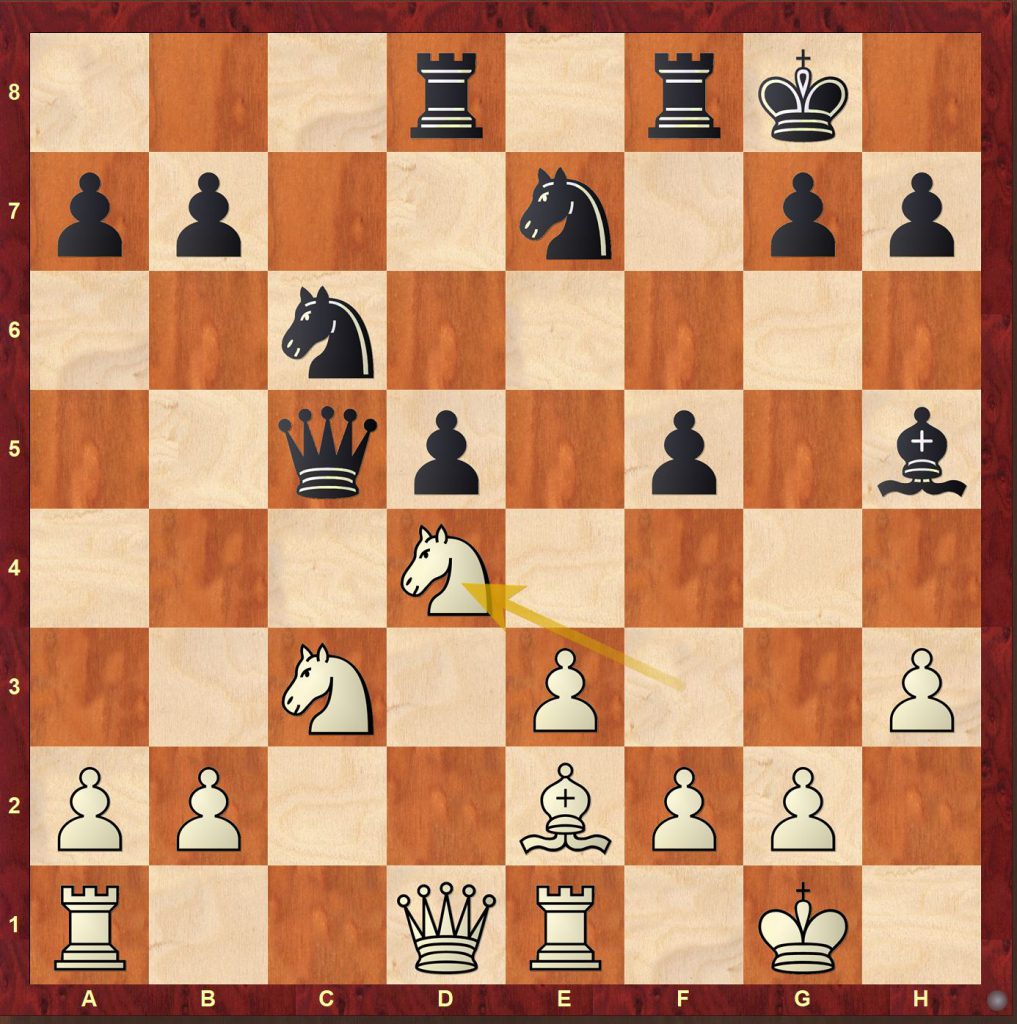
[Simple chess! After …f5, White’s ability to occupy the central d4–outpost with his knight increases further in value due to the central light square weaknesses (e.g. e6) created by the risky …f5.]
15…Bxe2 16.Ncxe2 Rf6 17.Qb3 Na5 18.Qd3 Nc4 19.b3 Nd6 20.Rac1 Qb6 21.Rc2 Ne4 22.Rec1

[Marshall has reached a huge position through the simplest means: occupying a central outpost and taking control of an open file! Marshall was 3 games down in the match but had stabilised the situation with 3 consecutive draws, so this was his big opportunity to get back into the match! This game is analysed in detail by John Nunn, so I’ll just focus here on the crucial moment in the game where Marshall lets his excellent position slip.]
22…a6 23.Nf4 g5 24.Rc7 Nc6 25.Nfe6 Ne5 26.Rg7+ Kh8 27.Rcc7
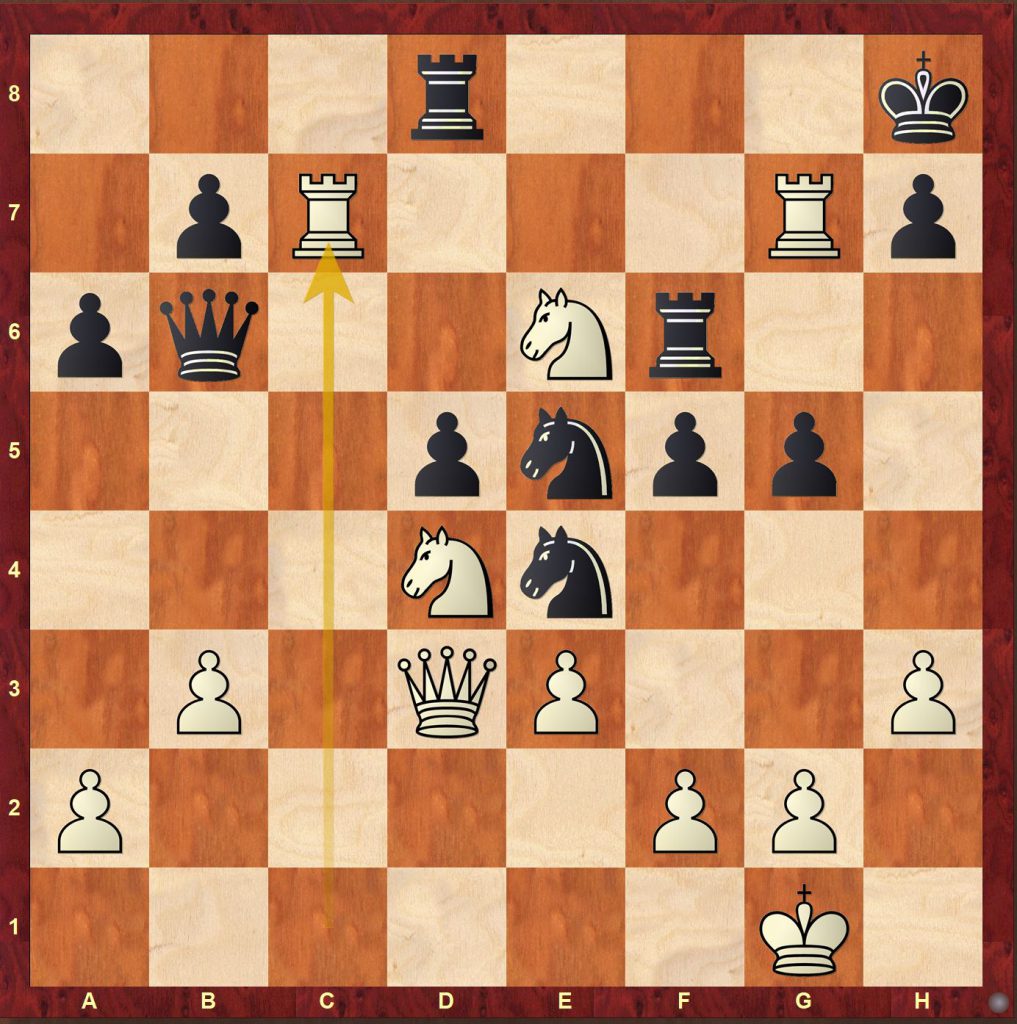
[As Nunn points out, 27.Qe2 and 27.Qd1 were probably both stronger, looking to exploit the doubled rooks on the seventh in a middlegame, rather than giving Black the chance to bail out to a confusing endgame.]
[27.Qe2 Rxe6 28.Rcc7 Nf6 29.Rxb7 Qd6 30.Nxe6 Qxe6 31.Rge7 Qc6 32.Rec7 Qe6 33.Ra7 followed by Qxa6 is Nunn’s main line and the engine’s too. White’s doubled rooks on the seventh, passed queenside pawns and Black’s open king should be sufficient for the win, even though Black is likely to be able to launch one last desperate attack before the game is closed off.]
27…Qxc7 28.Rxc7 Nxd3 29.Nxd8 Ndxf2 30.Rxb7 Nd1 31.Nf7+ Kg7 32.Nxg5+ Kg6 33.Nxh7 [33.Nge6 Nxe3 34.Nf4+ Kg5 35.Nde6+ Kh6 36.Ra7 was the way to do things. It still feels somewhat messy to a human, but my engine gives +3.6 which is pretty decisive. With so many knights flying around however, I wouldn’t like to have to play this with little time. Marshall’s move wins a second pawn, but has an unexpected consequence.]
33…Rf7 34.Rxf7 Kxf7 [The knight on h7 is trapped which suddenly makes the winning process more fraught. Marshall takes a radical decision that unfortunately throws away the rest of his advantage.]
35.Nxf5 [35.h4 supporting Ng5 was still promising, although Nunn considers that Black should be able to just hold the draw with best play.]
35…Ndc3 [35…Kg6 36.Ne7+ Kxh7 37.Nxd5 was the idea, with a lot of pawns for the knight. Lasker ensures he gets the very best version of this endgame.]
36.a4 Kg6 37.Ne7+ Kxh7 [The d5–pawn is protected so White only gets 3 pawns for the piece.]
38.b4 Nd6 39.Kf2 Kg7 40.Kf3 Kf6 41.Nc6 Nc4 42.b5 a5 43.b6 Nxb6 44.Nxa5 Ncxa4 45.h4 Nc5 46.g4 Nd3 47.g5+ Kf5 48.Nc6 Ne1+ 49.Kf2 ½–½




Your blog posts are absolutely fantastic. Can’t wait to read Game Changer!
Hi Robert, thanks a lot! Slightly biased, but I think the book is even better 😉 Hope you enjoy it! Best Wishes, Matthew
According to Hooper and Whyld (Oxford Chess Companion), Marshall’s best-games book was ghost-written by Reinfeld. This may explain the failure to mention the earlier game in the Mieses annotations.
I only encountered your CHESS TIPS FOR YOUNG PLAYERS long after I fit the title description, but have learned a great deal from it. Perhaps you will be able to write a new edition?